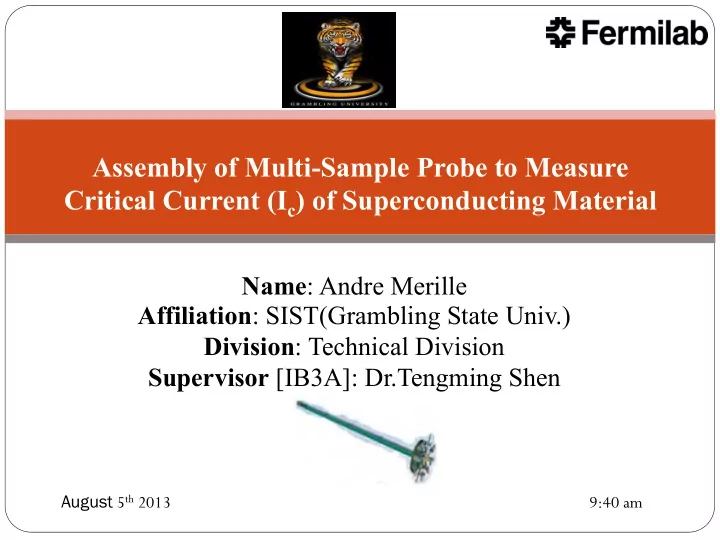

Assembly of Multi-Sample Probe to Measure Critical Current (I c ) of Superconducting Material Name : Andre Merille Affiliation : SIST(Grambling State Univ.) Division : Technical Division Supervisor [IB3A]: Dr.Tengming Shen August 5 th 2013 9:40 am
Overview: Why Build? Materials used Probe Assembly Heat Transfer Analysis Data Acquisition Results Conclusion Acknowledgements Questions?
Why Build? Can hold 8 Superconducting strands at a time. Opposed to previous models which held 1 or 2. Faster Turnover rate of Test Samples. Saves precious time. Reduces Cryogen Consumption. $6.00 per Liter 50-80 Liters per Sample Four fold decrease in Helium consumption. Receive better statistics on sample behavior.
Materials used: • G-10 Fiberglass-Laminate Insu Insulatio lation plat n plate Sam Sample ple-ho -holde lder r Su Suppo pport rings t rings Co Coppe pper le r leads ads
Silver-plat Silv -plated brass so d brass sock cket t conne co nnect ctors s G-10 G-1 0 sample sam ple holde ho lder r • G-1 G-10: im 0: impe pervio vious t s to mo moistu isture re, go , good insu d insulat lator and is e r and is easy t asy to car carve/grind. /grind. • Silv Silver is the r is the be best e st ele lectrical co ctrical condu nduct ctor o r of all me f all metals. tals. Use Used whe d when high do n high dose ses o s of cu f curre rrent are nt are re require ired d • Brass is be Brass is best f st for pre r preventing spar nting sparks. ks.
Materials used: Stainle Stainless st ss steel tu l tube be: protects the instrumentation wire which runs trough probe . Stainle Stainless st ss steel casing l casing : Protects probe. Instru Instrume mentatio ntation wire n wire: Copper alloy. 12 pairs of insulated wire through center of probe. Serves as voltage tap (Bo Bott ttom e m end nd).
After Af er Be Before TOP TO BOTT BO TTOM M Probe Assembly: Co Coppe pper t r to co coppe pper Brazing r Brazing Har Hard and So d and Soft So t Solde ldering ring Co Coppe pper Be r Bending nding
Probe Assembly: Why Brazing? Lower joining temperature than welding. Best used in tight situations [less access to surfaces]. Results in non-ferromagnetic joint (best for high-magnetic-field apparatus). How? Brazing metal Sil-F Sil-Fos (15): (5%) 5%)phosphorus, (80%) 80%)copper and (15 15%)silver . Applied around joint; heated; fills gap by capillary action. Fitted with very low tolerance [sleeve].
Heat Transfer Analysis: • To reduce Joule Heating. • Soldering of superconducting YBCO. m c ( T ) 2 d dT dT ( T ) I ρ ⎡ ⎤ p ( T ) 0 κ − + = ⎢ ⎥ 2 dx dx A dx A ⎣ ⎦ [V [Vapo apor-Co -Coole led Co d Coppe pper Cu r Curre rrent Le nt Lead] ad]
Temperature Profile: Standing Heat Input ( I =0) • Measurement of temperature increase along copper leads . • Determine where YBCO should be soldered. YBCO strip Graph o Graph of T f Tempe peratu rature re vs. distance vs. distance
Keithle ithley 200 2001 1 Data Acquisition: digital multi-me digital mu lti-meters s • Labview software • Graphic user interface • Enables user to control instruments, store, interpret and analyze data. Hewle He wlett P tt Pack ackar ard d 668 6681A DC po 1A DC power r su supply pply Shu Shunt nt Su Supplie pplies 600 Am s 600 Amps ps
Results: (Room temperature tests) Ω Voltage vs. Current 0.018 0.016 y = 0.0017x - 4E-05 0.014 0.012 Voltage(V) 0.01 0.008 0.006 0.004 0.002 0 -2 0 2 4 6 8 10 -0.002 Current (A)
Results: Liquid Nitrogen (77K) tests Ω Value Sample# Superconducting I C Material 1 YBCO 107 30 2 YBCO 103.3 28 3 YBCO 109.7 30 4 YBCO 107 29 5 YBCO 57* 17 6 YBCO 104 25 7 Bi2212 0.14 3 8 Bi2212 0.7 3
Conclusion: Multi-sample probe assembly was a success. Commissioned room temperature and liquid nitrogen tests.
Future Work: 4.2K tests in high-magnetic-field.
Other Projects: (ANSYS) • 2 dime 2 dimensio nsional mo nal mode del l of a co f a coppe pper wire r wire with with Bi22 Bi2212 po 12 powde wder r within the within the f filame ilaments. nts. • APDL co APDL code de. . • ANS ANSYS. S. • Fiji so Fiji softw tware are. .
Study of BSCCO conductor. • In Investigatio stigation o n of f 52 521, 522, 523, 52 , 522, 523, 524 4 co condu nduct ctors. s. • Pho Photosho shop (me p (merge rge pictu picture res fr s from SEM). m SEM). • Liq Liquid, AEC and CF id, AEC and CF phase phases. s.
What did I learn? Never grow to attached to the design or project. Stay critical and strive for perfection. Yes! even if it means going back to drawing board. Always think 3 steps ahead. Be the biggest optimist but remember things do go wrong sometimes. How to be more productive in a lab.
Acknowledgements: Fermilab SIST Committee Ms. Dianne Engram Dr. Elliott Mccrory Ms. Linda Diepholz Mentor: Dr. David Peterson Supervisor: Dr. Tengming Shen Co-workers: Pei Li, Yang Wang and Liyang Ye. Special thanks: Dr. Davenport
Qu Questio stions? ns?
Recommend
More recommend